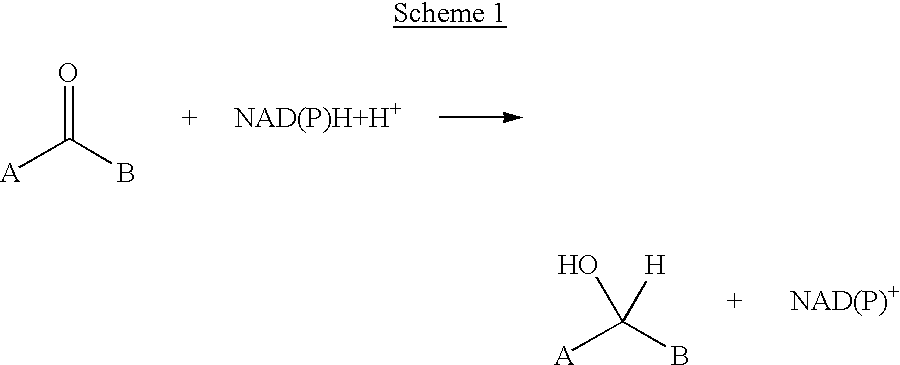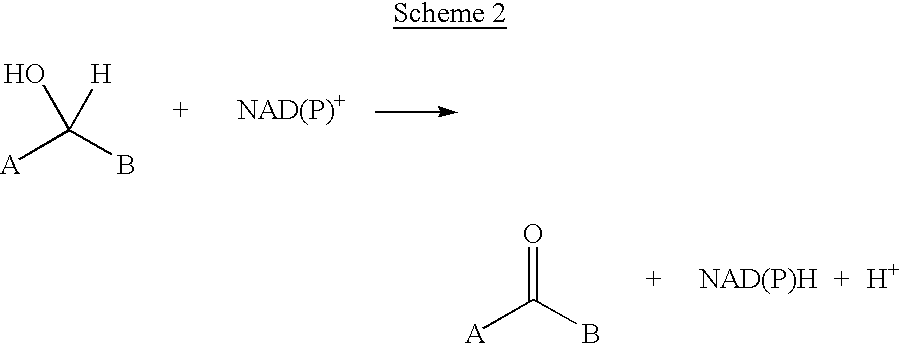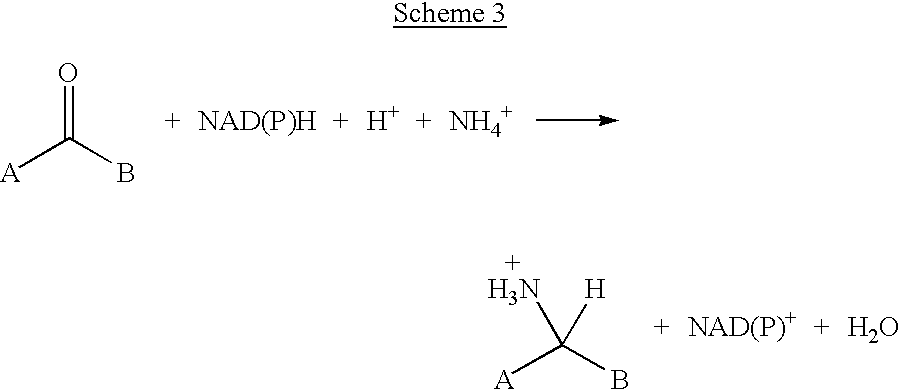Method for reductive amination of a ketone using a mutated enzyme
a technology of mutated enzymes and ketones, which is applied in the direction of enzymology, biochemistry apparatus and processes, transferases, etc., can solve the problems of difficult operation of crude mixture clarification, inability to identify suitable amino acid dehydrogenase for the production of many non-naturally occurring amino acids, and inability to catalyze enzymes
- Summary
- Abstract
- Description
- Claims
- Application Information
AI Technical Summary
Benefits of technology
Problems solved by technology
Method used
Image
Examples
example 1
General Procedure for Detection of an Enzyme that Reduces the Target Compound ethyl-4-chloro-3-ketobutyrate
[0042]A gene encoding the alcohol dehydrogenase YPR1 (described by Nakamura, K., et al., Bioscience, Biotechnology and Biochemistry, (1997) 61, 375–377), is subjected to mutagenesis by error-prone PCR according to the method of May, O., et al., (Nature Biotechnology, (2000) 18, 317–320). The error-prone PCR is performed in a 100 mL reaction mixture containing 0.25 ng of plasmid DNA as a template dissolved in PCR buffer (10 mM TRIS, 1.5 mM MgCl2, 50 mM KCl, pH 8.3), and also containing 0.2 mM of each dNTP, 50 pmol of each primer and 2.5 units of Taq polymerase (Roche Diagnostics, Indianapolis, Ind.). Conditions for carrying out the PCR are as follows: 2 minutes at 94° C.; 30 cycles of 30 sec 94° C., 30 sec 55° C.; 2 minutes at 72° C. The PCR product is double digested with Nco I and Bgl II and subcloned into pBAD / HisA vector (Invitrogen, Carlsbad, Calif.) which has been digested...
example 2
Detection of an Enzyme that Reduces the Target Compound ethyl-3-phenyl-3-ketopropionate
[0047]The procedure of Example 1 is repeated, replacing the ethyl-4-chloro-3-ketobutyrate with ethyl-3-phenyl-3-ketopropionate, thereby identifying at least one mutant alcohol dehydrogenase that catalyzes the desired reduction reaction.
example 3
Detection of an Enzyme that Reduces the Target Compound ethyl-indan-2-one-1-carboxylate
[0048]The procedure of Example 1 is repeated, replacing the ethyl-4-chloro-3-ketobutyrate with ethyl-indan-2-one-1-carboxylate, thereby identifying at least one mutant alcohol dehydrogenase that catalyzes the desired reduction reaction.
PUM
 Login to View More
Login to View More Abstract
Description
Claims
Application Information
 Login to View More
Login to View More - R&D
- Intellectual Property
- Life Sciences
- Materials
- Tech Scout
- Unparalleled Data Quality
- Higher Quality Content
- 60% Fewer Hallucinations
Browse by: Latest US Patents, China's latest patents, Technical Efficacy Thesaurus, Application Domain, Technology Topic, Popular Technical Reports.
© 2025 PatSnap. All rights reserved.Legal|Privacy policy|Modern Slavery Act Transparency Statement|Sitemap|About US| Contact US: help@patsnap.com



